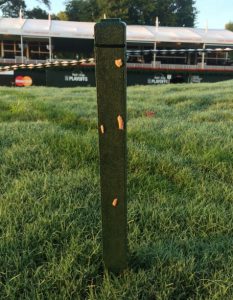Fall armyworm (Spodoptera frugiperda) (Fig. 1) is a caterpillar pest of turfgrass and usually appear on our sod farms, lawns, or golf courses starting late August in Georgia. In spring and summer, adults of fall armyworm or moths fly north from Florida through weather fronts each year. They undergo several generations of moths during summer and become noticeable in fall in Georgia. A fall armyworm caterpillar can be easily identified by an inverted “Y” marking on face (Fig. 2).
Fall armyworm moths lay several hundreds of eggs (Fig. 3) in batches appear as off white color, woolly or fussy mass on any surface they can find. Egg laying site can be leaf blade of grass, fence, walls of house, storage shed or barn. Caterpillars that hatch from these eggs feed on grasses before pupate in about three weeks.
Monitoring is the critical step for managing fall armyworm. Scout the lawns, sod farms or golf courses at least a week. They tend to initially infest the edge of the turfgrass and gradually move inward. The newly hatched caterpillar can be as small as 2-3 millimeters long. Once they start feeding, they grow in size. It is easier to manage caterpillars when they are small sized. A fully grown caterpillar can be more than an inch. Once an infestation is detected, it is time to treat with insecticide.
For management, try using Bt insecticide products, which are available for homeowners. They are effective when caterpillars are smaller and not effective on larger caterpillars. Products containing a pyrethroid insecticide such as bifenthrin, cyfluthrin, deltamethrin, etc. should provide adequate control. Newer insecticide, chlorantraniliprole is also effective for fall armyworm control.
Read the Armyworms in Sod publication for more information.


